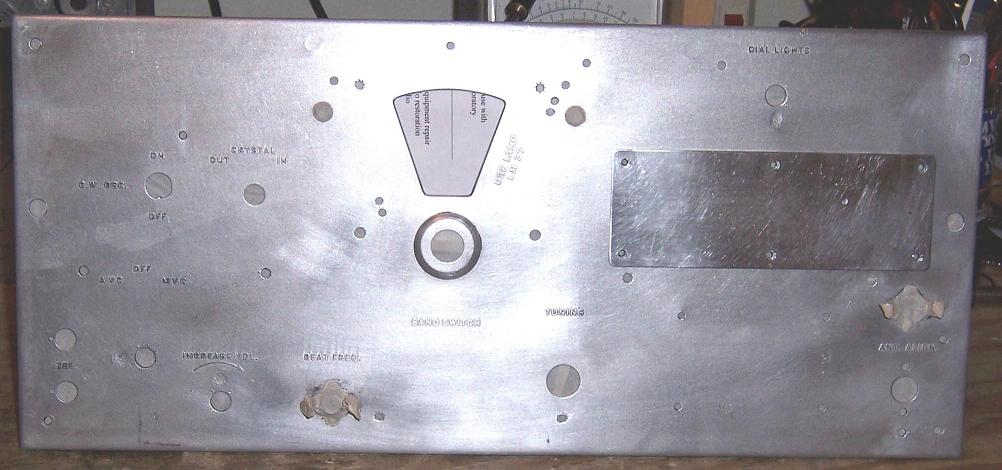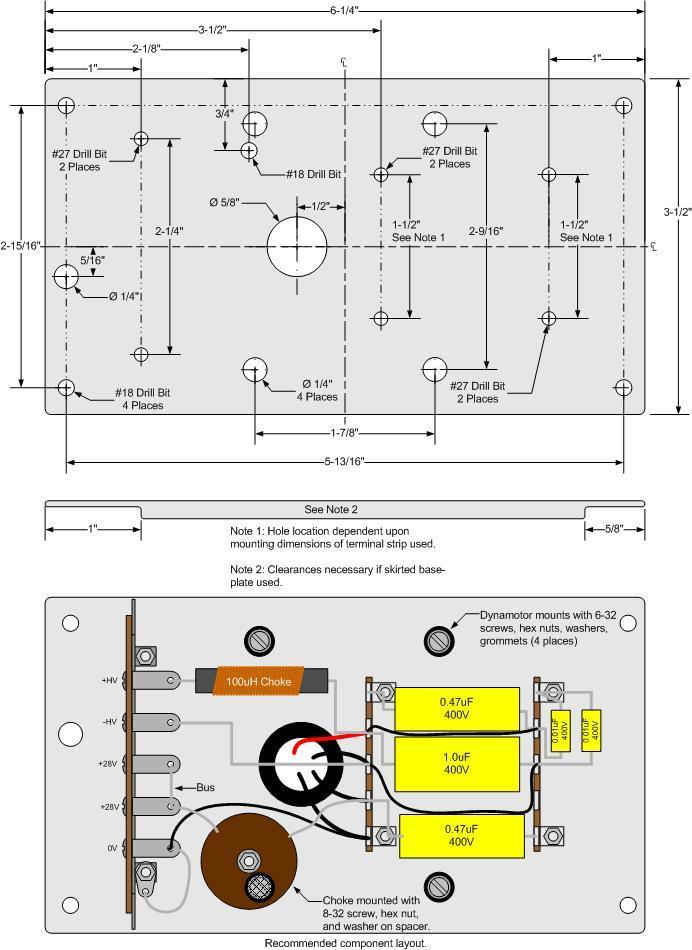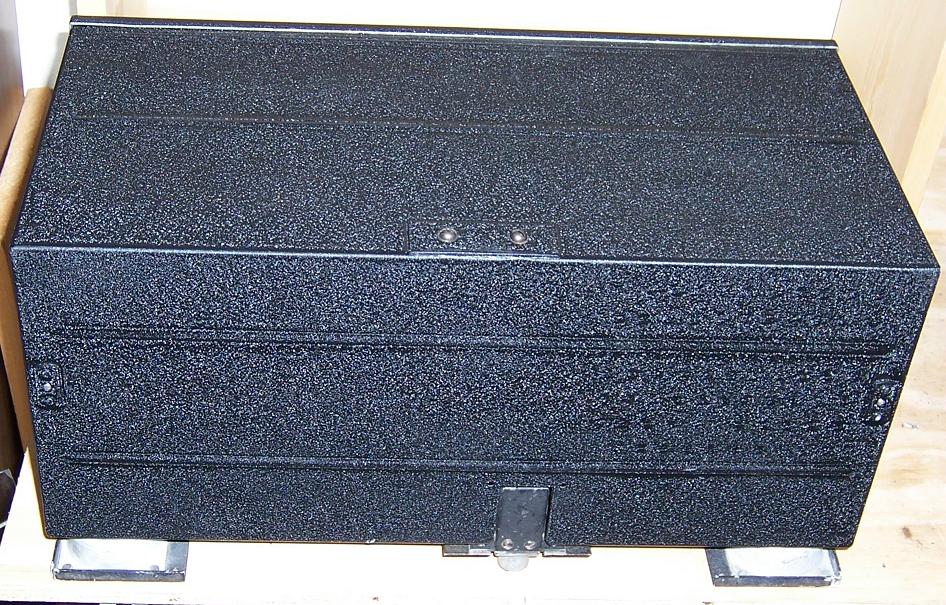Many older ham
radio operators are familiar with the legendary BC-348 receiver.
These sets were available on the postwar surplus market and often
heavily modified to make a really nice communications receiver.
The 348 was originally designed as the liaison receiver in larger
multi-engined Army Air Corps aircraft in the 1930s. These sets
were paired up with the BC-375 liaison transmitter to make up the
SCR-287 system. Later in the war the archaic BC-375 was replaced
by the Collins T-47 but the BC-348 remained as part of the ART-13
system.
There were many suffixes attached to the basic BC-348 model number.
Mostly this suffix designated the manufacturer and a specific
contract but it also denoted some differences in circuitry.
Companies
like RCA, Stromberg Carlson, Wells-Gardner, and Belmont cranked out
these sets by the thousands during W.W.II. Basically these sets
used eight tubes and covered 200Kc-500Kc and 1.5Mc-18Mc in six bands.
The sets were designed to operate from the 28VDC aircraft power
with a built-in dynamotor (DM-28) that provided 220VDC for the tube
plates. The
6.3V tube filaments and dial lamps were connected in a series and
parallel
combination to be powered from the 28VDC supply.
I have acquired two versions of this set: a BC-348-H manufactured by
Belmont Radio Crop., and a BC-348-M by Stromberg Carlson. I
wanted to restore one set back to its original configuration to be
powered from 24VDC using a dynamotor and installed in an FT-154 shock
mount. The H model I have had some of the usual ham modifications
including the
dynamotor being replaced with an AC power supply, the filaments being
rewired for 6V, and the 8-pin pseudo Jones connector being removed.
There were a few other minor circuit changes made as well.
However the
front panel had not been hacked up to install an S-meter, extra
switches
and controls, or replacing the antenna and ground terminals with an
SO-239
coax connector. The M also had the usual circuit changes but
still
retained the 8-pin SO-104 connector. The dial light control had
been replaced with a switch and the antenna and ground terminals were
replaced
with an SO-239. I could probably replace the light control but
the
SO-239 installation would be difficult to restore. I decided to
go
ahead and restore the H model using parts from the M to replace
anything
that was missing.
I found a complete manual at
James Moorer's
web site.
Cosmetic Restoration

Front of the BC-348-H before I
began restoration.
|

The rear of the cabinet. Notice the
numerous ventilation holes that had
been drilled.
|

The rear of the chassis showing the
AC power supply built on the
original dynamotor mount.
|
A previous owner of the BC-348-H pasted a circular logging scale behind
the main tuning knob and appeared to have slopped on some black paint
or other coating over the entire front panel. Trying to clean
this coating off also took off the original black wrinkle finish down
to bare metal. I decided that I would have to strip and repaint
the
entire front panel. The first thing I did was to remove all of
the
knobs so I could remove the panel. There are nine screws holding
the
panel to the chassis that need to be removed. The thumb screw
rods
that hold the chassis into the cabinet must be removed as well as the
handles. The dial bezel is held on with five screws from inside
the panel. The
antenna and ground terminals as well as any other components attached
to
the panel were removed.

The front panel after removal
from the chassis.
|
I stripped the panel down to bare metal with your run-of-the-mill paint
stripper. To be sure that I had good paint adhesion I washed the
entire panel down with acetone and then scrubbed it with hot soapy
water. I wore rubber gloves when handling the clean panel to keep
it clean. I found a web site with some hints on how to get good
results when applying wrinkle paint. I purchased some Plasti-Kote
black wrinkle paint from a local auto parts store. When it came
time to paint I turned the kitchen oven up to 250
oF and took
the panel outside to paint. I laid the panel on a piece of
plastic and spaced it above the ground with a couple of wooden blocks.
The directions on the can of paint called for applying a coat
then waiting ten minutes before recoating. It recommended using
three heavy coats to get good results.
When the last coat was completed I placed the panel in the oven,
closed
the door, and turned it off. I allowed the paint to cure in the
oven
for a few hours. The wrinkle turned out pretty well on the front
of the panel but the sides did not turn out as well. I attribute
this to the heating elements in my oven being on the top and bottom and
I had placed the panel horizontally to cure. If I had to do
another one I would probably line a box with aluminum foil to place the
panel in. Hopefully that would radiate heat to the sides.
The results can somewhat be seen in the photos below.

This is the panel after it was stripped,
cleaned, and masked.
|

The panel after being repainted.
|
The lettering on the panel is raised from the rest of the panel but not
by much. The thickness of two or three coats of paint is about
even with the thickness of the lettering. To expose the lettering
I carefully scraped the paint away with the blade of a small
screwdriver. I also stripped and repainted all of the knobs
except for the tuning knob with the same black wrinkle paint I used on
the panel.

The panel after being repainted.
|

The panel after exposing the lettering
and installation onto the chassis.
|
A previous owner had drilled a bunch of ventilation holes in the
cabinet. These would have to be filled. I stripped the
original paint
using the same stripper that had been used on the front panel. I
used
a couple pieces of fiberglass cloth coated with epoxy resin to act as a
backer
on the inside of the cabinet where the holes were located. Once
the
epoxy had cured, I could begin filling the holes with body putty.
With
the body putty cured it was sanded flush with the surface. The
cabinet
was then masked and primed with some galvanizing primer. After
that
was done it was ready for wrinkle paint.
Electrical Restoration
As mentioned before, the goal of this restoration was to put
this receiver back into its original military configuration. Any
electrical modifications had to be undone so it would function the way
it was intended. Most of these sets had the tube filaments
rewired
to run from 6V and this set was no different. I re-rewired the
filaments to run from 28V and removed jumpers across the dial light
dropping
resistors so that the lights would also run from 28V. There had
been
a couple of resistors added around the 6B8 detector that I removed as
well.
Capacitor & Resistor Replacement
Most of the capacitors in this radio are Micamold types. These
are paper capacitors that are formed to look like mica capacitors.
After 60+ years they fail just like the tubular paper caps.
In
fact, I tested one of the capacitors from this set for leakage on my
Eico 950B and it failed at 25V. The cap was rated for 500V.
There are four resistor boards under the chassis that contain both
resistors and capacitors. There are a bunch of Micamolds on
these boards in hard to reach positions.
Micamold capacitors mounted on either side of the
RF amplifier deck.
|
Underside of IF deck before restoration.
|
I replaced all of the Micamolds and checked all of the resistors.
Any resistors that were out of tolerance were replaced.
There is a 0.05uF capacitor inside the output transformer can
that is used as the AVC timing capacitor when the BFO is turned on.
This capacitor turned out to be leaky. Instead of opening
the can to replace it I just snipped the lead where it comes into the
chassis and installed a new 0.05uF capacitor on a terminal strip.
A screw on the chassis served to mount the strip and the
replacement cap can be seen just above the SO-104 connector in the
photo on the right below.

Underside of chassis before restoration.
|

Underside of chassis after restoration. You can see
the yellow replacement Mallory 150 series capacitors.
|
The seven boxes in the lower left corner of the chassis in the above
photos each contain two 0.5uF capacitors. I decided to
gut and restuff these boxes. The best way to open these boxes is
with a propane torch to melt the sealing solder and then to pry the lid
off with a screwdriver. The guts will usually come out with the
lid but if they don't they are not difficult to remove while the can is
still hot.





















